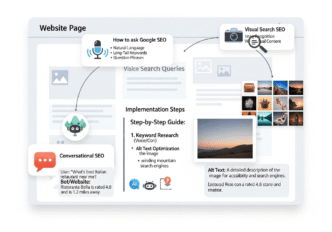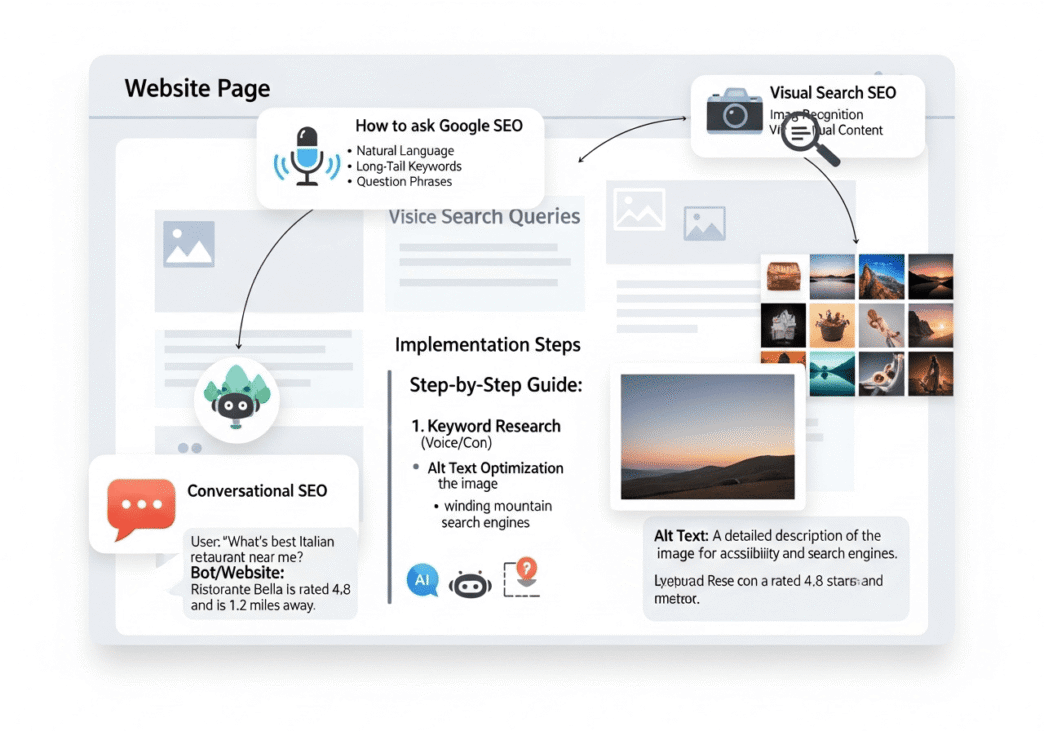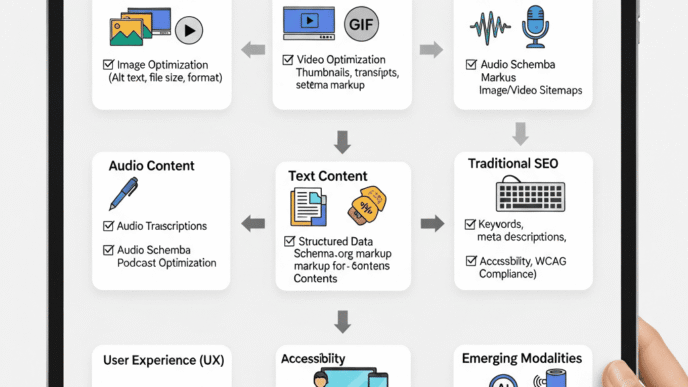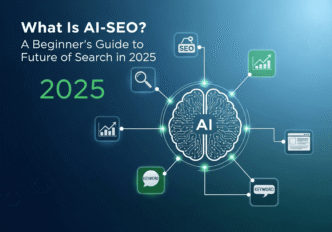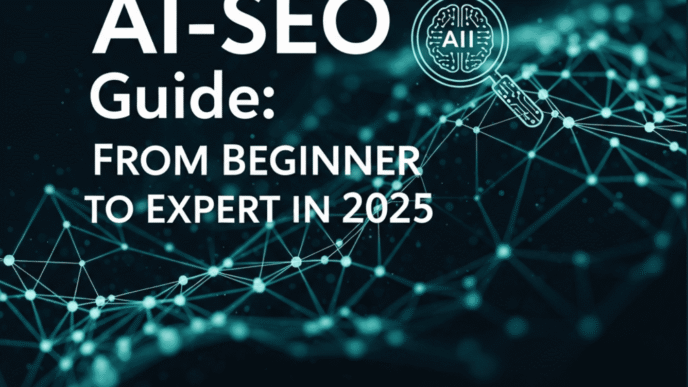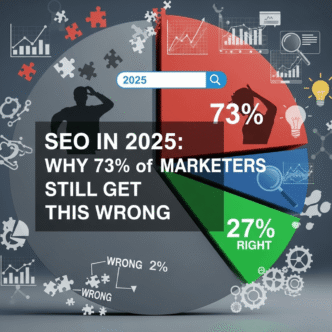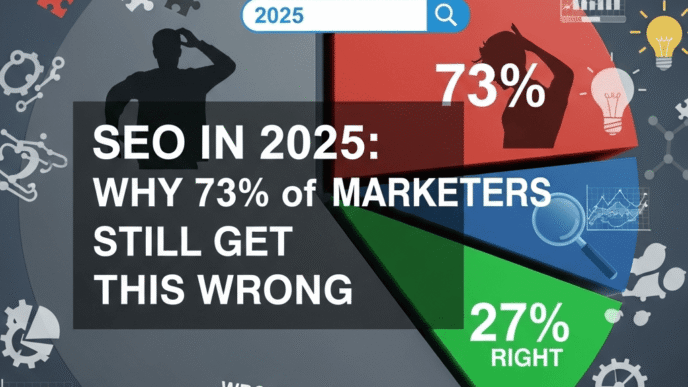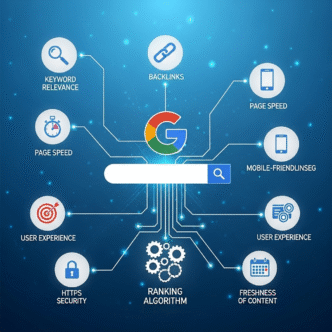Ever wondered why your website isn’t showing up when people ask Alexa for recommendations or search using images on their phones? Here’s the thing: traditional SEO isn’t enough anymore but to implement Multi-modal SEO.
Multi-modal SEO is the game-changer you’ve been missing. It’s the practice of optimizing your website for different types of search behaviors – voice queries, visual searches, and conversational AI interactions. Think of it as speaking multiple “search languages” fluently.
With around 20.5% of people worldwide actively using voice search and over 20 billion visual search queries every month using Google Lens, the multimodal revolution is here. Let’s dive into how you can transform your website into a multi-modal powerhouse that captures traffic from every angle.
Table of Contents
ToggleWhat Exactly Is Multi-Modal SEO and Why Should You Care?
Multi-modal SEO goes beyond typing keywords into Google. It’s about understanding that people now search by talking to their phones, snapping photos of products, and having conversations with AI chatbots.
Consider this: voice assistant usage statistics indicate that U.S. users are expected to reach 153.5 million in 2025. Meanwhile, visual search SEO is exploding as visual searches using Pinterest Lens exceed 250M+ monthly usage and platforms like Google Lens gain traction.
The bottom line? If you’re not optimizing for these different search modalities, you’re leaving money on the table. Companies that master multimodal SEO don’t just rank better—they connect with customers at every touchpoint of the modern search journey.
How Does Voice Search Optimization Actually Work?
Voice searches are fundamentally different from typed queries. When someone types, they might search “best pizza NYC.” When they speak, it becomes “Hey Google, where’s the best pizza place near me?”
Voice query optimization requires understanding natural language patterns. People use complete sentences, ask questions, and include conversational filler words. The average voice search results have a length of 29 words, showing how differently we communicate when speaking versus typing.
Here’s what makes voice search unique: it’s location-heavy, question-focused, and often seeks immediate answers. Your content needs to match this conversational style, especially since 76% of voice searches are for things nearby or local.
Step-by-Step Voice Search Optimization Tutorial
Step 1: Identify Voice Search Keywords
Start by thinking like your customers talk, not how they type. Use tools like AnswerThePublic or simply observe how people naturally ask questions about your industry.
Create a list of question-based phrases: “How do I…” “What’s the best way to…” “Where can I find…” Remember, nearly 20% of all voice search queries are triggered by a set of 25 keywords, consisting mainly of question words like “how” or “what” and adjectives like “best” or “easy”.
Step 2: Optimize for Featured Snippets
Voice assistants love pulling answers from featured snippets. Featured snippets account for 41% of voice search results. Structure your content to directly answer common questions in 40-60 words.
Format your answers clearly:
- Start with a direct answer
- Follow with supporting details
- Use bullet points or numbered lists when appropriate
Step 3: Implement Conversational AI SEO Elements
Add FAQ sections that mirror natural conversations. Instead of “Product Features,” use “What makes this product special?” This approach aligns with conversational AI SEO principles and matches how people naturally speak.
Pro Tip: Record yourself explaining your services to a friend. That natural language is gold for voice search optimization.
Why Visual Search SEO Is Your Secret Weapon
Visual search SEO is like having a crystal ball for customer intent. When someone photographs a dress they like, they’re not just browsing – they’re ready to buy something similar.
People use Google Lens for 12 billion searches each month, while Pinterest reports that 88% of users have purchased a product after seeing it on the platform. These aren’t just statistics; they’re opportunities waiting to be captured.
Image SEO becomes crucial here. But it’s not just about pretty pictures – it’s about making those images discoverable and actionable across multiple visual search platforms.
Complete Visual Search Optimization Guide
Step 1: Master Alt Text Optimization
Alt text optimization isn’t just for accessibility (though that’s important too). It’s your image’s voice in the search engine world.
Write descriptive, keyword-rich alt text that actually describes what’s happening in the image:
✅ Good: “Woman wearing red wool sweater while working on laptop in coffee shop”
❌ Bad: “Image1.jpg” or “Red sweater”
Step 2: Implement Visual Schema Markup
Schema markup for images tells search engines exactly what they’re looking at. Use Product schema for items you sell, Recipe schema for food images, and Organization schema for company photos.
Here’s a basic product schema example:
<script type=”application/ld+json”>
{
“@context”: “https://schema.org/”,
“@type”: “Product”,
“name”: “Blue Denim Jacket”,
“image”: “https://example.com/jacket.jpg”,
“description”: “Classic blue denim jacket with button closure”
}
</script>
Step 3: Optimize Image Technical Elements
Compress images without losing quality. Use descriptive filenames like “vintage-leather-boots-brown.jpg” instead of “IMG_1234.jpg.”
Choose the right format: WebP for modern browsers, JPEG for photographs, PNG for graphics with transparency.
Expert Insight: Images that load faster get indexed faster. Google’s PageSpeed Insights will tell you exactly how to optimize your images for speed. Fast-loading images are crucial since the average time required for a voice search results page to load is 4.6 seconds, which is 52% faster compared to average search results.
How to Leverage Structured Data for Multi-Modal Success
Structured data is like giving search engines a detailed map of your content. It’s the bridge that connects all your multi-modal efforts.
Think of it as translating your content into “search engine language.” When you use proper schema markup, you’re essentially saying, “Hey Google, this is exactly what this content is about.”
Semantic search relies heavily on this structured approach. Search engines don’t just match keywords anymore; they understand context, relationships, and intent. This is especially important as voice search assistants answer 93.7% of queries accurately thanks to better understanding of structured content.
Implementing Schema Markup: A Practical Tutorial
Step 1: Choose the Right Schema Types
Visit Schema.org and identify which schemas match your content. Common types include:
- LocalBusiness for location-based services
- Product for e-commerce items
- Article for blog posts
- FAQ for question-and-answer content
Step 2: Generate and Test Your Markup
Use Google’s Structured Data Markup Helper to create your schema. It’s like having a personal translator for search engines.
Always test your markup with Google’s Rich Results Test tool. This catches errors before they hurt your rankings.
Step 3: Monitor Performance
Check Google Search Console’s Enhancement reports regularly. This shows you which structured data is working and what needs fixing.
Common Mistake to Avoid: Don’t stuff irrelevant schema types onto your pages. Quality over quantity always wins in SEO.
Real-World Success: Learning from MultiModal SEO Champions
Let’s look at how smart companies are winning with multi-modal SEO:
Iowa Girl Eats Blog Success Story: Food blogger Kristin Porter leveraged multimodal optimization to achieve 508% growth in 3 months. Her secret? A generous implementation of recipe and review schema markup, winning attractive recipe snippets on SERPs, and food images ranking in Google image search. By optimizing for voice search queries like “easy dinner recipes” and ensuring her images appeared in visual searches, she captured traffic from multiple search modalities.
Hawthorn Mall’s E-commerce Breakthrough: During spring 2023, Hawthorn added 51K new pages to its online shopping platform, which tripled their keyword rankings (326K keywords) and triggered a jump in traffic. They combined traditional SEO with image optimization for visual search, helping customers find products through multiple discovery paths.
The key insight? These success stories show that multi-modal SEO isn’t about choosing one optimization type over another—it’s about creating synergy between voice, visual, and conversational search optimization.
What Are the Most Effective Multi-Modal SEO Strategies?
The most successful multi-modal SEO strategies create synergy between different optimization approaches. It’s not about choosing voice OR visual OR conversational – it’s about harmonizing all three.
Start with user intent mapping. What are people trying to accomplish when they search for your products or services? How do their search behaviors differ across modalities?
Since millennials tend to favor Alexa (33% have used it in the past month) while Gen Z are more loyal to Siri, understanding your audience demographics helps prioritize which platforms to optimize for first.
Then, create content ecosystems that serve multiple search types simultaneously. A single piece of content can be optimized for voice queries, include visual elements for image search, and incorporate conversational elements for AI interactions.
How Do You Measure Multi-Modal SEO Success?
Traditional metrics like keyword rankings tell only part of the story. Multi-modal SEO success requires a broader measurement approach.
Track voice search performance through position zero wins (featured snippets). Monitor image search traffic through Google Search Console’s search appearance filters.
Watch for increases in local search visibility, especially “near me” queries. These often indicate successful voice search optimization, particularly since voice searches on mobile are three times more likely to be for local information than text searches.
Pro Tip: Set up separate tracking for different search types. This helps you understand which multi-modal strategies deliver the best ROI.
Quick Start Multi-Modal SEO Checklist
Ready to implement multi-modal SEO on your website? Here’s your action plan:
Voice Search Essentials:
- Add FAQ sections with natural language questions
- Optimize for local search terms (crucial since 76% of voice searches are for things nearby or local)
- Create content that answers specific questions concisely
- Implement conversational AI SEO elements in your copy
Visual Search Optimization:
- Write descriptive alt text optimization for all images
- Use keyword-rich, descriptive filenames
- Implement relevant schema markup for visual content
- Optimize image loading speeds (remember: faster images get indexed faster)
Technical Foundations:
- Add structured data markup for your content types
- Ensure mobile-first responsive design
- Implement semantic search friendly content organization
- Create XML sitemaps for images
Content Strategy:
- Research voice query optimization keywords using conversational phrases
- Plan content around question-based searches
- Include location-specific information when relevant
- Balance conversational tone with informative content
Common Multi-Modal SEO Mistakes (And How to Avoid Them)
Mistake #1: Treating Each Modality Separately
Many businesses optimize for voice search, then separately tackle visual search, then work on conversational elements. This fragmented approach misses the synergies.
Solution: Plan your content strategy holistically. Ask yourself how each piece of content can serve multiple search types.
Mistake #2: Ignoring Technical Requirements
Multi-modal SEO has specific technical needs. Images need proper compression and schema. Voice search requires fast loading speeds. Conversational content needs proper heading structure.
Solution: Audit your technical SEO foundation before adding multi-modal elements. Fix speed issues, mobile responsiveness, and basic schema implementation first.
Mistake #3: Over-Optimizing for One Modality
Some websites go overboard with voice search optimization and forget about traditional search. Others focus solely on visual search SEO and neglect content quality.
Solution: Maintain balance. Your content should feel natural to humans while being technically optimized for machines.
Mistake #4: Underestimating Local Intent
With 82% of smartphone users turning to search engines to find local shops, and 58% of users discovering local businesses through voice search, ignoring local optimization is a costly oversight.
Solution: Prioritize local schema markup, Google My Business optimization, and location-specific content for all modalities.
Future-Proofing Your Multi-Modal Strategy
The landscape is evolving rapidly. Nearly 1 in 3 voice assistant users say they’ve used ChatGPT in the past month, showing how AI and voice search are merging into more sophisticated experiences.
What’s Coming Next:
Advanced AI Integration: Voice assistants are becoming more conversational and context-aware. Apple Intelligence gives Siri more awareness of personal context and the ability to act in and across multiple apps.
Visual Commerce Growth: Global purchases made via voice assistants on smart devices now total $164 billion in transaction value, and visual search is becoming more transactional.
Privacy Considerations: 28% of people are concerned about smart speaker privacy and data security, which may slow adoption in some segments but create opportunities for privacy-focused optimization.
Frequently Asked Questions About Multi-Modal SEO
What is multi-modal SEO and why is it important?
Multi-modal SEO is the practice of optimizing websites for different types of search behaviors including voice queries, visual searches, and conversational AI interactions. It’s important because search behavior is diversifying beyond traditional text-based queries, with 20.5% of people globally using voice search and over 20 billion visual search queries monthly on Google Lens.
How do I start with voice search optimization?
Begin by researching question-based keywords your customers might speak aloud. Focus on local search terms (since 76% of voice searches are for local content), create FAQ sections, and optimize for featured snippets. Remember that voice searches tend to be longer and more conversational than typed queries.
What’s the difference between regular SEO and multi-modal SEO?
Regular SEO primarily focuses on text-based search queries and traditional ranking factors. Multi-modal SEO expands this approach to include optimization for voice search, visual search, and AI-powered conversational interfaces, requiring different technical implementations and content strategies.
How important is alt text for visual search SEO?
Alt text optimization is crucial for visual search SEO. It helps search engines understand image content and makes your images discoverable in visual searches. With Google Lens processing 12 billion searches monthly, proper alt text can significantly impact your visual search visibility.
Can small businesses benefit from multi-modal SEO?
Absolutely. Small businesses often have advantages in multi-modal SEO, especially for local voice searches and niche visual content. Since 58% of users discover local businesses through voice search, local optimization can level the playing field against larger competitors.
How do I optimize for featured snippets?
Structure content to answer questions directly in 40-60 words, use clear headings, and format information with bullet points or numbered lists. This is crucial since featured snippets account for 41% of voice search results.
Ready to Transform Your SEO Strategy?
Multi-modal SEO isn’t just the future – it’s the present. Every day you wait is another day your competitors might be capturing voice searches, visual discoveries, and conversational queries that should be coming to you.
The data speaks for itself: 61% of 25-64-year-olds say they’ll use their voice devices more in the future, and 93% of Pinterest users utilize the platform to plan purchases. The multimodal search revolution is accelerating, and early adopters are capturing the biggest rewards.
Start with one modality that makes the most sense for your business. Master it, measure the results, then expand your approach. Remember, multi-modal SEO is about meeting your customers wherever and however they search.
The search landscape is evolving rapidly. Voice assistants are getting smarter, visual search is becoming more accurate, and conversational AI is handling increasingly complex queries. Your SEO strategy needs to evolve too.
Which multi-modal SEO strategy will you implement first? The choice is yours, but the time to start is now.
Ready to dominate multimodal search? Start implementing these strategies today and watch your website capture traffic from voice, visual, and conversational searches across all platforms.

